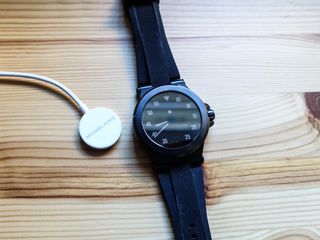Why phone makers should take a break from making Android Wear smartwatches

Christmas came and went and no one I know received a smartwatch as a gift. Conversely, I saw plenty of mechanical watches sprouting up on social media — I even received one for Christmas.
Admittedly, that's not a benchmark for how smartwatches are performing, but it is a valid reminder that smartwatches have had a relatively slow year. The Apple Watch had lost some traction, and while Google was prepping the Android Wear 2.0 update, some manufacturers decided they're better off hanging out on the sidelines for a while.
2017 is supposedly the banner year for this niche product category, especially for the incredibly abundant group of Android Wear smartwatches. But as Android Central's Alex Dobie wrote in his editorial, smartwatches need a "less is more" approach, because right now there are way too many. The good news is that there are plenty of companies that have taken a pause from Android Wear for the new year, so we won't be bombarded with new designs as the platform figures itself out. Here's my plea to those manufacturers who might be considering taking their place.
Seriously, less is more

There are way too many Android Wear smartwatches. Huawei has several varieties. Fossil, Michael Kors, and LG do, too. And Asus just introduced its third-generation ZenWatch. In the new year, Google will launch two more smartwatches, which will add to the already lengthy list of devices compatible with Android Wear 2.0.
This is a very good thing for Google. It means the new version of Android Wear 2.0 will have plenty of wrists to land on, which means plenty of people using Google services on the go. But more smartwatches means more confusion, and Android Wear has yet to establish its narrative among the general populace. Is it for the nerds, for the athletic, or for the fashionable? It's obviously for everyone, but how do you choose which one is for you?
Let Google handle that by letting its "Nexus" watches shine for the year. It means Google will have to handle the marketing effort, but it's doing pretty well with the Pixel thus far, and even Google Home and Daydream View. If Google can convince a manufacturer to work with it behind the scenes on its future smartwatches, like it did with HTC for the Pixel lineup, that means it can control the marketing, software updates, styles, and customer support. Having all that be a centralized experience — rather than a fragmented one — will make it easier to sell to those who may already be apprehensive about Android as a platform.
There needs to be more innovation
Responding to a message by typing the reply on a 1.4-inch screen is neither cool nor innovative. It's simply meaningless, and it does nothing to push the Wear platform forward.
Be an expert in 5 minutes
Get the latest news from Android Central, your trusted companion in the world of Android
I'm with The Register on this one: the "Wouldn't it be cool?" factor should not be applied to wrist wearables. Yes, it is cool to do that thing with your smartwatch, but if it's not a necessity, it shouldn't be marketed towards consumers who already lead complicated lives.
Maybe it's time to reimagine their use case.
Until Google figures out what consumers do want from their wrists, manufacturers should sit out the race. Companies like LG and Asus have done little to add to the Android Wear platform, save for encouraging you to download a proprietary app that adds "extra features." And with the demand for new smartwatches at an all-time low, maybe it's time to reimagine their use case, too.
Leave it to the fashion brands
It's not that technology companies aren't capable of great design, but they sell technology, not style. The only other technology-first manufacturer that's been relatively successfully with wearables is Apple, and that's because it's already established itself as a design company in both technology and fashion.
I know — this sounds like ridiculous pop culture vernacular, but the disparity is obvious. Just look at the way that Michael Kors advertises Android Wear compared to Asus. Michael Kors focuses on the functionality compared to Asus, which uses buzzwords around component names but fails to explain why custom widgets would be useful.
Android Wear could try existing in two parts: Google's part and fashion's part. Google could continue to working with major brands to make fashionable timepieces, while also fostering development with its "Nexus" watch program. That would ensure that as more people adopt a smartwatch from their favorite designer, it's using Android Wear, and eventually, it's name would be become synonymous with all the major fashion houses available at the department store.
Florence Ion was formerly an editor and columnist at Android Central. She writes about Android-powered devices of all types and explores their usefulness in her everyday life. You can follow her on Twitter or watch her Tuesday nights on All About Android.

